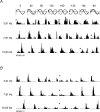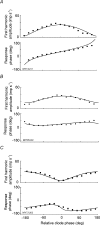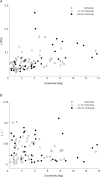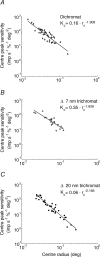Chromatic and spatial properties of parvocellular cells in the lateral geniculate nucleus of the marmoset (Callithrix jacchus)
- PMID: 15047769
- PMCID: PMC1665047
- DOI: 10.1113/jphysiol.2003.058065
Chromatic and spatial properties of parvocellular cells in the lateral geniculate nucleus of the marmoset (Callithrix jacchus)
Abstract
The parvocellular (PC) division of the afferent visual pathway is considered to carry neuronal signals which underlie the red-green dimension of colour vision as well as high-resolution spatial vision. In order to understand the origin of these signals, and the way in which they are combined, the responses of PC cells in dichromatic ('red-green colour-blind') and trichromatic marmosets were compared. Visual stimuli included coloured and achromatic gratings, and spatially uniform red and green lights presented at varying temporal phases and frequencies.The sensitivity of PC cells to red-green chromatic modulation was found to depend primarily on the spectral separation between the medium- and long-wavelength-sensitive cone pigments (20 or 7 nm) in the two trichromatic marmoset phenotypes studied. The temporal frequency dependence of chromatic sensitivity was consistent with centre-surround interactions. Some evidence for chromatic selectivity was seen in peripheral PC cells. The receptive field dimensions of parvocellular cells were similar in dichromatic and trichromatic animals, but the achromatic contrast sensitivity of cells was slightly higher (by about 30%) in dichromats than in trichromats. These data support the hypothesis that the primary role of the PC is to transmit high-acuity spatial signals, with red-green opponent signals appearing as an additional response dimension in trichromatic animals.
Figures










References
-
- Benardete EA, Kaplan E. The receptive field of the primate P retinal ganglion cell, I: Linear dynamics. Visual Neurosci. 1997;14:169–186. - PubMed
-
- Brainard DH. Cone contrast and opponent modulation color spaces. In: Kaiser PK, Boynton GM, editors. Human Color Vision. Washington, DC: Optical Society of America; 1996. pp. 563–577.
-
- Cavonius CR, Estévez O. Sensitivity of human colour mechanisms to gratings and flicker. J Opt Soc Am A. 1975;65:966–968. - PubMed
-
- Chan TL, Martin PR, Clunas N, Grünert U. Bipolar cell diversity in the primate retina: Morphologic and immunocytochemical analysis of a New World monkey, the marmoset Callithrix jacchus. J Comp Neurol. 2001;437:219–239. - PubMed
Publication types
MeSH terms
Substances
LinkOut - more resources
Full Text Sources

